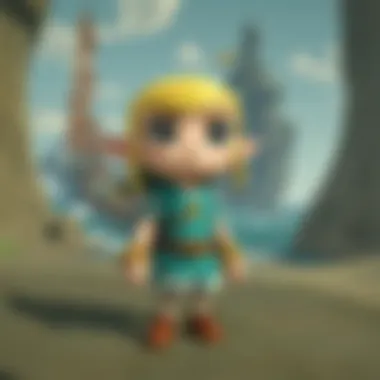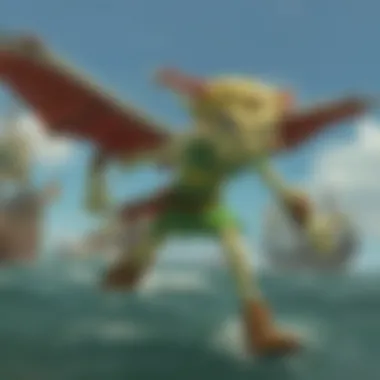Unveiling the Transformative Impact of Zelda Wind Waker on GameCube's Gaming Realm


Game Reviews
Zelda Wind Waker made a significant impact on the GameCube console, setting new standards in gameplay, visual design, narrative depth, and community reception. Critics and gamers alike lauded the game for its innovative mechanics and captivating art style. The gameplay features and mechanics of Zelda Wind Waker introduced sailing as a central element, providing players with a vast oceanic world to explore. The cel-shaded visuals brought a unique charm to the series, diverging from traditional graphics to deliver a visually stunning experience. Sound design complemented the gameplay, enhancing immersion and emotional engagement. Compared to its predecessors, Zelda Wind Waker offered a fresh take on the beloved franchise, setting a new benchmark for future titles.
Character Analyses
The world of Zelda Wind Waker is populated with a diverse cast of characters, each playing a crucial role in Link's journey. From the fearless Link to the enigmatic Ganondorf, every character was meticulously crafted to resonate with players on a deeper level. Character development and backstories added layers of complexity, shedding light on their motivations and inner struggles. Popular characters like Zelda and the enigmatic King of Red Lions captivated audiences with their unique traits and contributions to the overarching storyline. Fan theories and speculations further enriched the characterizations, sparking discussions and deepening the appreciation for the game's narrative depth.
Lore Discussions
Delving into the mythology and worldbuilding of Zelda Wind Waker unravels a rich tapestry of legends and lore. Legendary items and artifacts, such as the Master Sword and Triforce, play pivotal roles in shaping the narrative and empowering the protagonist. The game's link to real-world mythologies adds a layer of intrigue, drawing parallels between fictional realms and historical tales. The timeline placement and theories surrounding Zelda Wind Waker further deepen the lore, fueling debates and speculations among fans. The meticulous attention to detail in worldbuilding showcases the depth of thought invested in creating a cohesive and immersive gaming experience.
Gameplay Strategies
Mastering combat techniques and unraveling intricate puzzles are essential components of conquering Zelda Wind Waker. From efficient swordplay to strategic use of items, players must hone their skills to overcome formidable foes and challenges. Puzzle solutions and walkthroughs provide invaluable guidance for navigating the game's intricate dungeons and quests. Collectibles and side quest guides offer incentives for exploration, rewarding players with hidden treasures and special items. Boss battles tactics and strategies equip players with the knowledge needed to emerge victoriously against imposing adversaries, testing their skills and wit in thrilling encounters.
Intro
In the realm of gaming history, certain titles stand out as beacons of innovation, shaping the very landscape of interactive entertainment. One such monumental game that left an indelible mark on the GameCube console is Zelda Wind Waker. This article delves deep into the profound impact that Zelda Wind Waker had not only on the GameCube itself but also on the gaming industry as a whole. By dissecting its gameplay mechanics, visual art style, storyline, and reception within the gaming community, we unravel the intricate web of influence that this game wove during its time. The Introduction sets the stage for a meticulous exploration of how Zelda Wind Waker catalyzed a revolution in the world of gaming aesthetics and functionality.


With a keen eye on specific elements, this article embarks on a journey through the corridors of Zelda Wind Waker's significance. By shedding light on the game's pivotal role in redefining player expectations and pushing the boundaries of artistic expression in video games, we unveil the multifaceted impact that resonates even today. We delve into the benefits reaped by Nintendo through Zelda Wind Waker's release, from critical acclaim to the cultivation of a dedicated fan base. Considerations about the Introduction extend beyond mere narration, delving into the nuanced interplay between nostalgia, innovation, and industry evolution.
The Introduction sets the tone for what follows––a comprehensive analysis that elevates the discourse surrounding Zelda Wind Waker beyond the realms of traditional gaming reviews. It serves as the gateway to a trove of insights waiting to be unearthed by enthusiasts eager to dissect not just the gameplay mechanics but the very soul of a game that transcended its time. As we venture further into the intricacies of Zelda Wind Waker's impact on the GameCube, the Introduction stands as a beacon, guiding our exploration with a blend of scholarly curiosity and unabashed admiration for a title that left an indelible mark on the annals of gaming history.
The Legacy of Zelda Gamecube
The Legacy of Zelda Gamecube stands as a pivotal point in the history of gaming, a foundation upon which future titles drew inspiration. This section delves deep into the essence of Zelda Wind Waker's impact on the GameCube console, highlighting its unique gameplay mechanics, artistic design, and immersive storytelling. The Legacy of Zelda Gamecube encapsulates a blend of innovation and creativity that elevated the gaming experience to new heights. Players immersed themselves in a world where exploration and adventure melded seamlessly, setting a new standard for game development.
Zelda Wind Waker: An Overview
As the flagship title for the GameCube, Zelda Wind Waker garnered attention for its bold departure from traditional Zelda art styles. The game's cel-shaded graphics introduced a vibrant, cartoonish world that divided opinion among fans initially. However, over time, players embraced this fresh approach, recognizing the beauty in its artistic rebellion. The storyline follows Link on a seafaring adventure to rescue his sister in a vast oceanic world filled with mystery and danger. Players navigate dungeons, solve puzzles, and engage in epic boss battles, all while sailing the open seas aboard the iconic talking boat, King of Red Lions.
Innovative Gameplay Mechanics
Zelda Wind Waker revolutionized gameplay mechanics through its use of the Wind Waker baton, allowing players to control the wind and manipulate the environment. This tool, combined with the introduction of the sailboat as a mode of transportation, opened up a new dimension of exploration and puzzle-solving. The game's combat system enhanced sword fighting with dynamic moves and combos, adding depth to player engagement. Additionally, the seamless integration of music into gameplay further enriched the immersive experience, shaping the player's emotional connection to the game world.
Artistic Design and Visual Aesthetics
The artistic design of Zelda Wind Waker remains a standout feature, combining colorful environments, expressive character designs, and whimsical animations. The cel-shaded graphics brought a timeless quality to the game, transcending technological limitations of the era. Each island visited revealed a unique artistic vision, from lush forests to barren deserts, creating a diverse and visually captivating world. The attention to detail in character expressions and environmental design added depth to the game's narrative, drawing players further into the enchanting realm of Hyrule.
Exploration and Adventure Elements


Exploration lies at the core of Zelda Wind Waker, with a vast ocean waiting to be discovered. Players chart their course, seeking out hidden treasures, secret islands, and legendary dungeons scattered throughout the sea. The freedom to sail in any direction fostered a sense of agency and discovery, encouraging players to engage with the world at their own pace. The game's nonlinear progression allowed for varied gameplay experiences, enticing players to revisit areas with newfound tools and knowledge, ensuring a sense of continual exploration and growth.
Music and Soundtrack
The music and soundtrack of Zelda Wind Waker are a symphony of emotional resonance, enhancing every moment of gameplay with evocative melodies. From the iconic main theme that stirs feelings of heroism and adventure to the haunting tunes of boss battles that quicken the pulse, the soundtrack elevates the player's immersion in the game world. Each musical piece complements the visual storytelling, setting the tone for epic encounters, tender moments, and awe-inspiring exploration. The seamless integration of sound effects further enhances the player's connection to the game environment, making every action feel impactful and meaningful.
Game Reception and Critiques
Upon release, Zelda Wind Waker received a mixed reception from fans and critics alike, primarily due to its departure from traditional Zelda aesthetics. However, over time, the game garnered a dedicated fan base that appreciated its innovation and charm. Critics praised the game's adventurous spirit, engaging gameplay, and imaginative world design, highlighting its enduring appeal. While some critiques centered on the pacing of the game and the reliance on sailing mechanics, Zelda Wind Waker ultimately solidified its place as a beloved classic in the Zelda franchise, paving the way for future titles inspired by its bold approach.
Technical Advancements and Limitations
In the realm of gaming evolution, the discourse surrounding technical advancements and limitations plays a pivotal role in shaping the narrative of Zelda Wind Waker on GameCube. Understanding the technological strides made while also acknowledging the constraints faced sheds light on the intricate dance between innovation and feasibility. The significance of this topic within the article lies in uncovering how advancements in technology propelled the game's development forward while also recognizing the boundaries within which the creators had to operate. By delving deep into the technical aspects, we can appreciate the exhaustive efforts invested in pushing the boundaries of what was achievable on the GameCube platform. This section serves as a cornerstone in our quest to unravel the transformative impact of Zelda Wind Waker on both the gaming industry and its devout followers.
GameCube Hardware Capabilities
Scrutinizing the GameCube hardware capabilities is akin to excavating the foundation upon which Zelda Wind Waker rests. The technical prowess of the console not only determined the parameters within which the game designers could unleash their creativity but also dictated the user experience for players diving into the enchanting world of Hyrule. From processing capabilities to graphical rendering, the GameCube's hardware intricacies influenced every visual and interactive aspect of Zelda Wind Waker. Grasping the nuances of these capabilities provides insight into the technological canvas on which this gaming masterpiece was painted. By peering under the hood of the GameCube, we gain a profound appreciation for the intricate symbiosis between software brilliance and hardware efficiency that underpins the gaming experience.
Challenges Faced During Development


The developmental journey of Zelda Wind Waker was not devoid of hurdles, with challenges presenting themselves at various stages like formidable adversaries on Link's quest. Unraveling the intricate web of obstacles encountered during the game's creation unveils the relentless pursuit of excellence that defined the development process. From technical constraints pushing the limits of creativity to unforeseen design hurdles demanding innovative solutions, each challenge served as a crucible that tempered the game into the masterpiece it became. By shedding light on these development challenges, we gain a more profound understanding of the dedication and perseverance woven into the fabric of Zelda Wind Waker, elevating our appreciation for the game and the creative minds behind its conception.
Influence on Subsequent Zelda Titles
The influence wielded by Zelda Wind Waker extends far beyond its debut on the GameCube, casting a long shadow that continues to shape subsequent titles in the legendary franchise. As each new Zelda installment emerges, echoes of Wind Waker's innovative spirit reverberate, leaving indelible marks on gameplay mechanics, artistic direction, and thematic depth. Analyzing the ways in which Wind Waker paved the path for future Zelda titles offers a glimpse into the ongoing legacy of this iconic game. By tracing its influence through later releases, we gain a holistic perspective on how Zelda Wind Waker's footprint reverberates across the expansive landscape of gaming culture, solidifying its position as a true titan in the realm of video game history.
Cultural and Industry Impact
Exploring the intersection of cultural and industry impact within the realm of gaming offers a profound insight into how a single title, like Zelda Wind Waker, can transcend mere entertainment to shape artistic direction and industry standards. The fusion of cultural elements with economic considerations creates a dynamic landscape where creativity meets commerce. In the case of Zelda Wind Waker, its distinctive art style blended with innovative gameplay mechanics not only captivated players but also set benchmarks for visual storytelling in video game development. By delving into the cultural and industry impact of this game, we unravel the intricate dynamics that influence how gaming experiences are crafted and consumed.
Zelda Wind Waker's Influence on Art Direction
Zelda Wind Waker's influence on art direction reverberates through the industry till this day. The bold decision to embrace cel-shaded graphics breathed new life into the Zelda franchise, steering away from conventional realism towards a timeless, animated aesthetic. This departure from the tried-and-tested path revolutionized how developers approached visual design, emphasizing artistic expression over technical fidelity. The game's art direction not only garnered acclaim but also inspired a wave of creativity, influencing future titles to prioritize distinct visual styles that resonate with players on a deeper level.
Community Reactions and Discussions
The community reactions and discussions surrounding Zelda Wind Waker echoed a mix of adoration and skepticism. While some praised the game for its bold departure from norms, others questioned its departure from traditional Zelda aesthetics. This dichotomy sparked vibrant debates within the gaming community, shedding light on the subjective nature of artistic choices and narrative direction in video games. By analyzing these diverse reactions, we gain a nuanced understanding of how player expectations intersect with developer intentions, shaping the ongoing discourse within the gaming sphere.
Critical Analysis of Game Narrative
A critical analysis of Zelda Wind Waker's game narrative unveils a multi-layered tapestry of storytelling elements. From the epic quest of Link to the emotional depth of character interactions, the game weaves a narrative that resonates with players on a deeply emotional level. While some critics lauded the narrative for its thematic richness and character development, others pointed out pacing issues and narrative gaps. By dissecting the game's storytelling prowess, we navigate through the nuances of narrative construction in video games, illuminating the intricate balance between player engagement and narrative cohesion.







